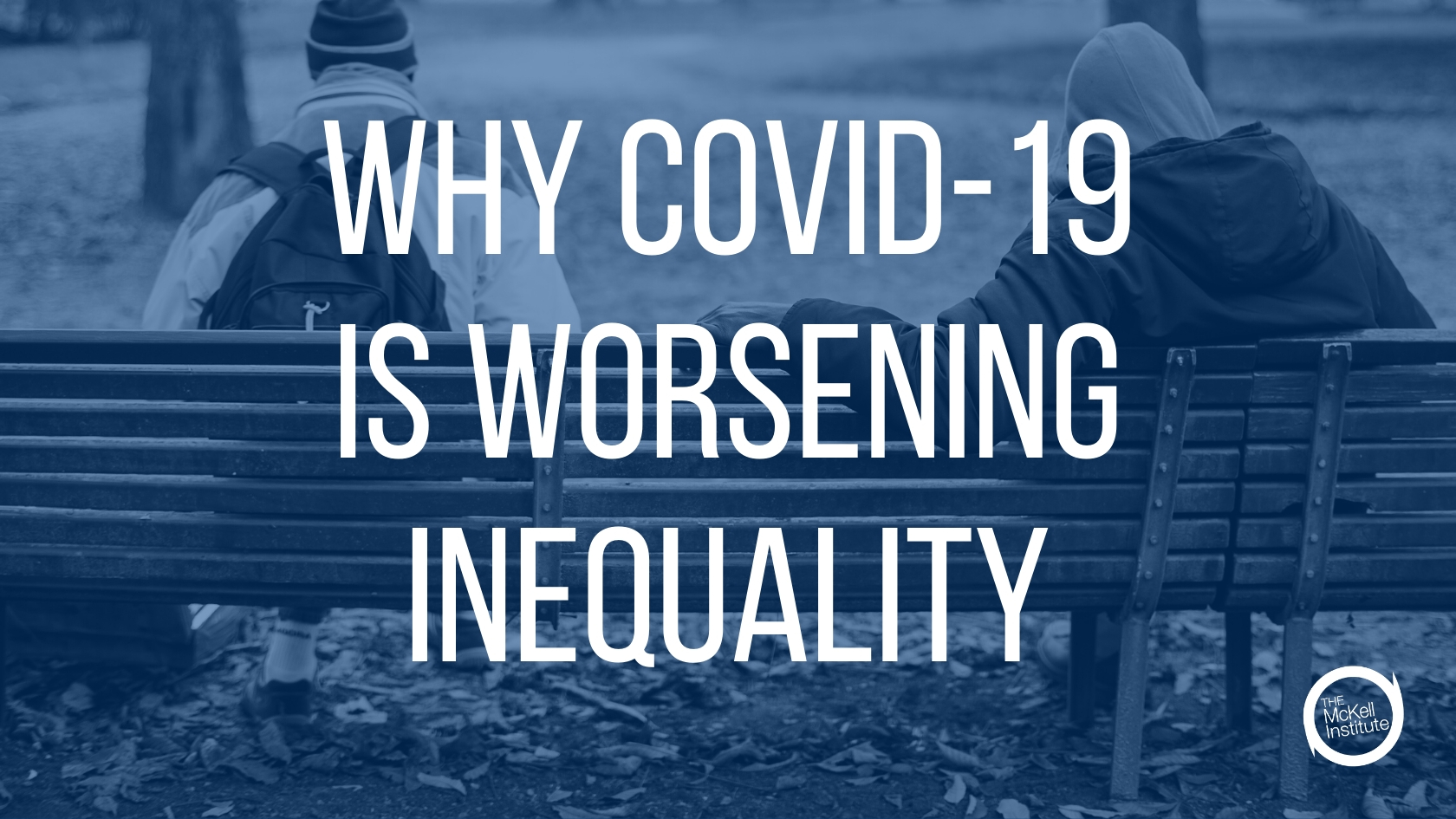One of the immediate impacts of the coronavirus in Australia will be an increase in the level of inequality. The pandemic has created a sudden and unexpected trifurcation of the Australian labour market, with the country’s 13 million workers being split into three categories:
• knowledge workers who can work from home,
• frontline workers, a broad group ranging from doctors to supermarket checkout operators, who still have jobs but now risk contracting coronavirus at work, and
• Others, the workers who find themselves suddenly unemployed or underemployed
The categories are by no means perfect or finally constructed. Knowledge workers may find themselves needed for only so long as the stream of current work created by past investment decisions holds up and some categories of frontline workers, such as those in non-essential retail trade, mining and construction may continue to work only as long as low levels of community spread mean the current relatively light lockdown can be sustained.
Nonetheless, the sudden trifurcation exposes a stark inequality, as those who are able to work from home were already the best off.
The workforce has split in three
Estimating a split across the three categories identified presents a challenge at this early stage. Nonetheless, the McKell Institute estimates that around 40% of the workforce are knowledge workers, around 40% are frontline and around 20% are others who are currently unemployed or underemployed.
The ABS categorises the workforce in two ways; by occupation and sector. Both are valuable in determining who is working and who is not.
While ‘knowledge workers’ do not form their own formal category within the Australian labour market, we can assume they are those whose work is conducted from behind a desk and whose primary tools are their education, their networks, a computer and a phone.
Of the eight ABS occupation categories, knowledge workers will come almost exclusively from three; professionals, managers and, less precisely, clerical and administrative workers. Not all of those people will now be working (bar managers, for instance, will not) but if we take from the ABS data that those three occupations comprise 50% of the workforce and assume most are working from home, we conclude that 40% of the entire workforce are knowledge workers.
In addition to the occupation categories above, the ABS splits the workforce into industry sectors, a data set that allows us to determine the proportion of workers in frontline services such as health and education (classifying teachers working online as frontline rather than knowledge workers) and the proportion in industries such as accommodation and food services and the Arts which are largely shut down.
From that data, we can estimate that around 40% of the workforce is frontline (comprising the 28.1% in public administration and safety, education and health plus a smattering from other groups) and around 15-20% are ‘others’, comprising the majority of the 9% of the workforce in accommodation and food services and the Arts plus some from other categories.
This assessment of a 40% at home, 40% at work and up to 15-20% out of work split is consistent with the Reserve Bank’s recent assessment that total hours worked will fall by 20% during the pandemic and with trends observed so far. Toll road figures for instance show traffic is down in Australian cities by 38 to 54% , and Treasury reports that 850,000 businesses have expressed interest in JobKeeper (with an average of more than one worker per business) while 517,000 individuals have registered for JobSeeker.
Knowledge workers are already the best paid
The difficult irony of the pandemic is that the people most likely to be working from home were already in a superior financial position. Before the pandemic, the knowledge worker categories of managers and professionals were the two highest earning at an average of $47 an hour and clerical and administrative workers the third highest paying category at around $32.
The categories in which affected workers are most likely to fall; labourers, tradespeople and personal service workers had pre-pandemic median wages of $25 to $30 an hour. That is, they earned 40% less than knowledge workers.
These predictions for the overall labour force impacts of the pandemic are corroborated by the early data released by the ABS.
Data released on sectoral employment impacts during the first three weeks of the lockdown from March 14 to April 4 show the industries most affected were accommodation and food services, with a 25% reduction in employment, and Arts and recreation, down 18%.
Accommodation and food services was already the lowest paid industry sector with Arts and recreation being the third lowest. The second lowest paid sector, retail trade, has seen just a 2.7% reduction in overall employment, though any tightening of the lockdown would undoubtedly lead to far wider retail closures.
The one notable exception in the trend is Mining. That sector has by far the highest average weekly wage of any in the economy, $3,488 per week (pre COVID-19) compared to $2,102 for the next category, financial services. Mining has so far been the third most impacted sector from COVID-19, recording an 8.4% reduction in overall employment.
Newly unemployed were already under financial strain
While the Federal Government has been praised for its second stimulus package, which doubled unemployment benefits to around $1,100 per fortnight and the third package, which introduced the $1,500 per fortnight JobKeeper payment for employees in business which had seen revenue drops of 30% or more, these payments will leave many people unable to meet their living expenses.
Before the pandemic, the average fulltime individual wage in Australia was $3,318 and average household living expenses were $2,850 per fortnight with, as the graph below shows, most of those living expenses being fixed. To translate, those average living expenses could only be met – just – by two people on JobKeeper. With many households incorporating only one wage earner or one wage earner and a casual (who would not be eligible for JobKeeper if employed for less than 12 months), the arithmetic means that many people will not be able to cover their living expenses.
Inequality is now stretching into the next generation
In 2018, the McKell Institute released Mapping Opportunity, a landmark report that looked at how access to economic opportunity was unevenly dispersed across Australia. It found that wealth and income inequality were increasing (the finding on income being consistent with work undertaken by the Commonwealth Treasury) that Australia ranked poorly in the OECD on measures of economic mobility across generations and that economic opportunity was geographically concentrated, with inner city residents faring well while families in outer metropolitan, regional and remote areas were significantly worse off.
The key point of Mapping Opportunity was to warn that, without policy intervention, this inequality would become worse in the transition to a digital economy as factors like unequal access to education and the internet compounded across generations.
The COVID-19 pandemic is creating a sudden and unexpected insight into that digital future. While much of the stress is no doubt playing out right now behind closed doors, it is fair to conclude that knowledge working households will have shifted relatively seamlessly to online learning for the children while those out of work or underemployed may be struggling to afford the $50 baseline cost of NBN, let alone to apply the skills needed to supervise students learning digitally from home.
Government can do more
Unequal access to the internet is a crucial issue that needs to be addressed. With as many as 2.5 million households without internet including 56,000 with children at home, the government needs to consider a federal rollout to provide home internet connections to those currently without. Current schemes in which Telstra has worked with state governments to provide SIM cards to disadvantaged students are a strong philanthropic contribution but internet is a systemic federal issue and support for baseline NBN connections for families with children would only incur the Government an additional $2.7 million in the budget, a minuscule but highly impactful figure in the face of over $213.6 billion dollars already committed to stimulus.
The savings crisis among disadvantaged people must also be addressed. In 2017, the McKell Institute released a report on the need for a Social Emergency Savings plan.
The Social Emergency Lending (SEL) scheme would allow all Australians earning under $100,000 per annum to access a low-interest loan of up to $500, and would be revenue neutral for the Commonwealth Government.
Rachel Nolan is a former Queensland Finance Minister. She is the Executive Chair of the McKell Institute, Queensland.



SOCIAL SHARE